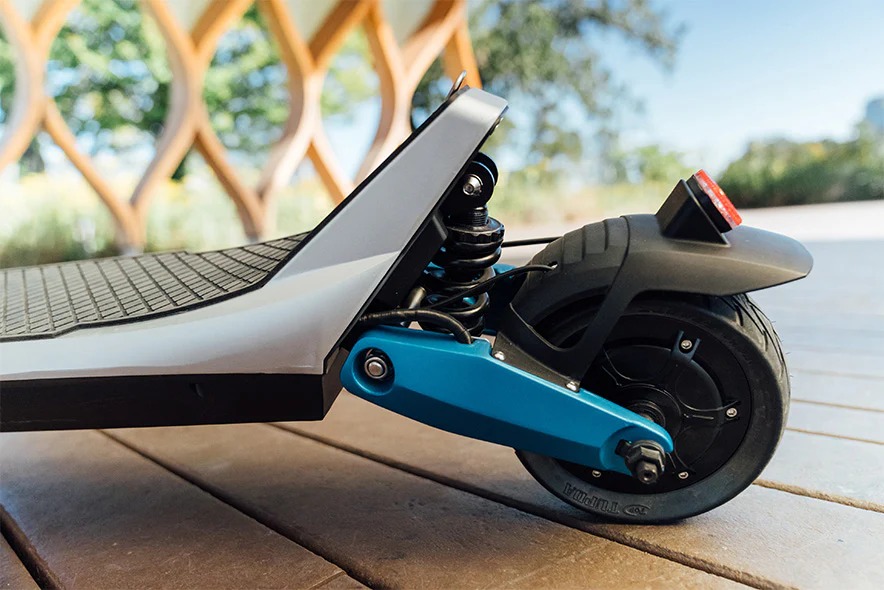If you’re hearing an irritating squeak every time you ride your electric scooter especially when going over bumps you’re not alone. Rear shock absorber squeaks are one of the most common complaints among scooter riders, especially those using models like the Kukirin G2, Vsett, or Apollo series.
You may have already tried spraying WD-40 on the hinges or even wedging some cardboard in the spring to silence the noise. Unfortunately, these are only temporary solutions or worse, could make the problem harder to solve later.
This article will explain why your rear suspension is squeaking and guide you through the right way to fix it permanently.
Why Your Rear Shock Absorber Is Squeaking
Let’s break down what’s causing that annoying sound.
1. Lack of Lubrication
Most electric scooter suspensions come dry from the factory or lose lubrication quickly due to exposure to dust, rain, and road grime. Without proper lubrication, metal parts rub against each other, creating a high-pitched squeak.
2. Dirt and Debris Buildup
Scooters without a rear mudguard (like the Kukirin G2) allow dirt and sand to collect around the spring and hinges. When this builds up, it increases friction, especially when the scooter compresses under weight or movement.
3. WD-40 Isn’t a Long-Term Fix
WD-40 may seem like the go-to solution, but it’s not a real lubricant. It’s actually a water displacer and a penetrant. While it might quiet the squeak for a day or two, it quickly dries up and can strip away remaining lubrication, making the problem worse.
4. Loose Suspension Bolts
Over time, the bolts that hold the suspension to the swing arm or frame can loosen due to vibration and riding stress. Loose bolts create unwanted movement and noise at pivot points.
5. Friction Between Rubber or Plastic Components
Sometimes, what sounds like a suspension squeak might actually be rubber rubbing on metal or plastic inside the assembly. This can be even harder to diagnose unless you take it apart.
What Not to Do
Before we go into how to fix it, here are common mistakes you should avoid:
- Don’t keep applying WD-40 — it will not lubricate the joint for long and may damage rubber seals.
- Don’t jam objects like cardboard between springs to stop the sound. You’ll likely create more resistance and possibly damage the spring mechanism.
- Don’t ignore the noise — it usually gets worse over time and may indicate wear or damage.
Step-by-Step: How to Fix a Squeaky Rear Shock Absorber
Step 1: Clean the Area Thoroughly
Use a dry cloth or soft brush to remove dirt and debris from around the spring, bolts, and hinge points. If it’s very dirty, use a bit of water and mild degreaser (like dish soap diluted with water) to wipe it down.
Tip: Avoid spraying water directly into the suspension area. Always wipe it down and let it dry completely before applying lubricant.
Step 2: Check All Bolts and Screws
With a wrench, carefully tighten all mounting bolts that hold the suspension and swing arm in place. Over time, vibrations from riding can loosen them, causing movement that leads to squeaks.
Optional: Use blue Loctite threadlocker to prevent bolts from loosening again.
Step 3: Apply a Real Lubricant
Choose one of the following recommended lubricants:
- Silicone Spray Lubricant: Safe for rubber and plastic parts.
- White Lithium Grease: Long-lasting and good for metal-to-metal contact.
- Graphite Lubricant: Ideal for dry conditions but not great in rainy environments.
How to apply:
- Spray directly into the spring hinge and pivot points.
- Use a small straw nozzle for precision.
- Move the suspension up and down manually to help the lubricant spread.
Avoid: WD-40 (unless it’s the Silicone version) or engine oil—they’re either too thin or not rubber-safe.
Step 4: Install a Rear Mudguard (If Missing)
If your scooter doesn’t come with a rear fender or spring cover, you should install one ASAP. Mudguards protect your suspension from dust, water, and road salt, reducing wear and noise.
Some Kukirin G2 users report a dramatic drop in squeaking just by adding a mudguard.
Step 5: Test Ride and Adjust
Take a short ride to test for the squeak. If it’s gone—great! If not, recheck bolt tightness and reapply lubricant to any missed spots. Sometimes the squeak can shift to a new location, so listen carefully.
Expert Advice from the Community
We gathered some valuable comments from real scooter owners who’ve battled this problem before:
“White lithium grease did wonders for my Vsett 10+. WD-40 just made it worse.”
– MildewJR
“You’re hearing rubber on metal, not metal on metal. Silicone lube is the fix.”
– electricguy101
“WD-40 dries up fast. Use real suspension-safe lubricant. CRC 5-56 or silicone spray worked for me.”
– Zealousideal_War_720
“Tighten all bolts and use blue Loctite to keep them tight. Suspension stress can loosen them fast.”
– Murky-Smoke
Bonus: Quick Maintenance Checklist to Keep Squeaks Away
| Task | Frequency |
| Clean suspension and swing arm | Weekly |
| Check and tighten bolts | Bi-weekly |
| Apply lubricant | Monthly |
| Inspect spring and seals | Monthly |
| Add or check mudguard | Once |
Conclusion: Silence That Squeak for Good
A squeaky rear suspension isn’t just annoying—it can indicate lack of maintenance or early mechanical wear. By avoiding WD-40, cleaning regularly, and using the right type of lubricant, you’ll restore smooth and quiet performance to your electric scooter.

